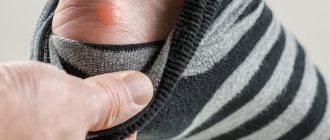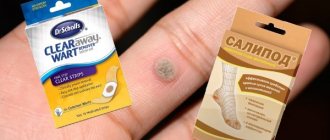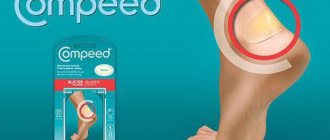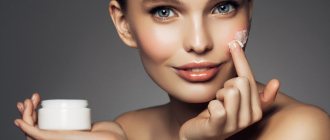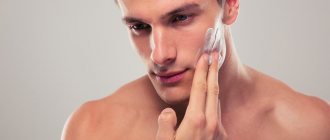Calluses or hyperkeratoses are local changes in the skin associated with exposure to damaging factors on an area of the body.
Literally translated, “hyperkeratosis” means “excess of keratin,” a substance that causes hardening.
The skin loses its elasticity, becomes less sensitive to external influences, and feels rough to the touch.
Defects in ICD10 are allocated to a special nosological group L84 - “Calls and calluses”.
Mostly calluses form on the skin of the hands and feet, where the epidermis (skin) contains, among others, a shiny layer.
It provides increased skin density as an adaptation to external pressure or friction.
As a result, the skin becomes denser in defense and calluses form.
Classification of calluses
A dry callus is a limited area of yellowish, keratinized, thickened, dense skin.
Painful when located at the base of the fingers on the plantar or palmar surface.
Calluses on the heels lead to the formation of cracks, which can become painful and become infected.
Causes of dry calluses:
- work in a standing position
- long walk
- tight and narrow shoes
- working with tools (construction, musical, sports, power tools)
- dry skin where calluses form
- thinning of subcutaneous fat in areas where calluses form
A soft callus—otherwise known as a wet callus—is saturated with moisture and softens, forming blisters.
Microtraumas cause inflammation with damage to the deep layers of the skin.
Under the pressure of the released interstitial fluid, the surface epidermis rises.
Moisture sweats inside and bubbles form.
A typical place for the formation of such calluses is the interdigital folds.
Such calluses cause extreme pain and are dangerous when the bladder is opened due to the risk of infection.
Causes of soft calluses:
- microtraumas and cracks
- wet skin where calluses form
- thinning of the skin and subcutaneous fat
- tight shoes or tight wet gloves
- wet socks or stockings
- increased sweating of the feet
- thinning of the skin and infection
A core (or “ingrown”) callus is a dense, round area of hyperkeratosis.
With clear boundaries and a hard transparent whitish rod in the center, when viewed it resembles a lid.
They are formed in response to injury by a foreign body (stone, splinter) in places where bone bases press on soft tissue.
The rod consists of a stratum corneum, as hard as a nail plate.
Therefore, when vertical pressure is applied to the callus, severe pain is felt due to compression of the dermal nerves.
Callus must be distinguished from plantar warts, since the treatment indicated is different.
A plantar wart is similar in appearance to a callus, but its surface looks loose, with brown dots.
And pain appears with any pressure, including from the sides.
There is usually only one core callus, and small, daughter similar formations form next to the large wart.
Causes of callus formation:
- high heels shoes
- work in a standing position
- untreated soft callus
- viral and fungal infections
- microtrauma of the skin
- constant pressure or rubbing of a specific area of skin
- diabetes
- flat feet
Subungual keratosis, in which the nail folds appear as thickenings on the side of the nail plate in the form of a dense yellow-gray mass.
The nail becomes dense, dull, deformed, and partially destroyed on both sides.
Such formation may indicate a fungal infection of the nail.
Therefore, you should see a mycologist, as well as the development of panaritium or an ingrown nail.
Reasons for the formation of subungual keratosis:
- failure to comply with hygiene rules
- diabetes mellitus (diabetic foot)
- violation of the trophism of the skin of the feet
- nail phalanx injuries
Corns are areas of hardened skin on the plantar surface of the foot.
Causes of corns formation:
- tight shoes with insufficiently rigid and thin soles (calluses in the heel area)
- high heels (corns in the big toe area)
- displacement of the center of gravity with valgus or varus position of the feet (corns on the lateral surface of the foot)
- Reduced spring function of the foot due to flat feet (calluses all over the sole)
Children more often develop soft (“wet”, “weeping”) calluses that look like a bubble with liquid.
Reasons for the formation of a soft callus with a blister in children:
- Tight shoes
- Shoes with rough seams, made of leatherette
- Shoes that are too big (not the right size)
- Large socks or tights that bunch up when wearing shoes
In women, soft (“wet”) calluses are more common on the upper extremities when working in their summer cottage or in places where they are compressed by tight shoes.
Often, core and dry types of calluses appear as a result of constant pressure or friction.
For example, when working with sports (stick, dumbbells, barbells, clubs) or athletic (mechanical and electrical simulators) equipment.
Or when constantly carrying heavy loads.
Dry calluses are common among musicians, in particular on the fingers of a guitarist or calluses on the fingers and chin of a violinist.
Older people can develop all types of calluses.
Age-related dry skin stimulates the formation of dry calluses and corns.
Thinning of the skin leads to cracks and the formation of wet calluses; ingrown toenails are formed due to poor foot hygiene against the background of subungual keratosis.
Painful sensations and impaired sensitivity of the feet lead to the risk of falls in an elderly person, or even refusal to walk.
With a long course of the disease, bedsores may appear on the feet.
What types of calluses can there be?
Calluses can be of the following types:
- Dry callus.
It is also called a hard callus. It can be shaped like a circle or an oval; the skin on it dies, so this callus is often yellow in color. If the callus is shallow, then it will not cause physical discomfort to the person. Such skin growths are purely a cosmetic defect. If the dry callus is large and deep, it can cause pain while walking.
- Wet callus.
In this case, the skin peels off with the formation of a bubble. It will be filled with lymph. It is a clear liquid that contains blood cells that perform a protective function. If the bubble bursts, the resulting gap can become an entry point for infection. You should not deliberately open wet calluses; you need to wait until they go away on their own.
- Dry callus.
Such a callus is a growth of keratinized skin cells, in the center of which there is a rod. It goes deep into the sole. If you do not get rid of the core, the callus will appear again and again. Therefore, treatment of such growths must be targeted. Often dry calluses are combined with various infectious processes, for example, a fungal infection.
Calluses most often form on the lower extremities. You can get rid of them with a patch. There are several types of patches. They all have different shapes and are also impregnated with different medicinal compounds.
How to treat calluses at home
The best way to treat calluses at home, without involving a doctor, is to use special patches.
Pharmacies often offer a variety of products targeting different types of calluses.
Each patch has instructions included in the packaging or printed directly on it.
Mode of application:
- The limb should be lightly steamed and blotted dry.
- Lubricate the healthy part of the skin around the callus with baby cream or Vaseline.
- Remove the protection, place the membrane impregnated with the medicinal composition strictly on the skin defect
- Fix the patch and wear for 1-2 days
Patches for dry calluses
Patches often used for dry calluses should contain emollients and moisturizers and substances: urea or salicylic acid.
A patch with salicylic acid eliminates the stratum corneum, relieves local inflammation, and prevents the development of cracks.
The use of the patch in patients with allergic reactions is possible only after consulting an allergist.
The Leiko dry calluses patch is a fabric strip with a membrane impregnated with salicylic acid.
The application time for one patch is 2 days.
The Urgo salicylic patch features a foam pad that protects healthy skin from the effects of salicylic acid.
Perforation ensures the prevention of the “greenhouse effect”, preventing macerations.
Time to use the patch is 24-48 hours.
A clear disadvantage of the product is the risk of allergic reactions.
Hands remain a little sticky after use due to the adhesive base of the patch.
Salicylic acid is found in Chinese Jiyantie and Shulyangsuan patches along with phenol.
Has an antiseptic, softening, analgesic effect.
The use of patches in patients with diabetes and children is excluded due to high concentrations of active substances.
Plasters for dry calluses and corns are manufactured by the following companies:
- Dr. House
- Johnson & Johnson (Compeed dry callus patch)
- Hartmann (Cosmos patch for dry calluses)
Compeed and Cosmos foot callus patches have a translucent texture.
This allows them to be used on the hands, face, back of the foot, little finger).
In addition to softening, the patch provides an environment that stimulates active division and growth of new epidermal cells.
Luxplast spray patch is most often used for soft calluses.
But it is able to create a protective film that protects dry callus from further friction.
You can also use Foretal Plus cream, containing 25% urea in combination with phospholipids.
Types of callus plasters
Calluses and corns vary in appearance and symptoms. Formations on the skin of the legs are:
- Wet, appearing as a small bubble filled with liquid. The cause is rubbing the skin with uncomfortable shoes.
- Dry, representing a localized, compacted area of the epidermis. They develop due to prolonged pressure on the same part of the foot.
- With a core, when a dry callus has a cone-shaped core that penetrates into the deep layers of the skin. Reaching the nerve endings, such a formation causes severe pain while walking.
Calluses in appearance are very similar to dry calluses without calluses, but have a much larger area. They represent an area of the epidermis of increased density with a yellowish tint. These tumors do not cause pain and are much easier to treat.
One of the easiest ways to eliminate a callus or corns is to use special patches. Moreover, it is necessary to choose the appropriate remedy based on the nature of the problem. Most often, calluses and corns are removed using the following types of patches:
| Type of patch | Description |
| Band-Aid | It is a piece of special adhesive tape, on which a pad with medicinal impregnation is applied. There may be a protective silicone or cellophane coating on top |
| Silicone | Made from silicone gel. It looks like a transparent strip with an adhesive surface. It is convenient because it is invisible when worn, as it is small in thickness. This patch can be glued to different parts of the body without fear of irritation. |
| Solipodous | The main active component of this patch is salicylic acid. After gluing the protective film, this substance penetrates into the deep layers of the epidermis and there has a softening effect on the coarsened layers. Has antibacterial and antiseptic properties |
| Liquid | When applied to a damaged area, it dries to form a protective film. The coating has an elastic structure and allows oxygen to pass through to the skin. Apply using a brush or spray. Protects against infection and promotes healing |
| Hydrocolloid | It is a sticky strip that provides a healing effect and prevents water from entering the damaged area of the skin. |
Plasters for core calluses
For core calluses, the choice is usually the Salipod patch.
It contains salicylic acid, precipitated sulfur, lanolin and natural rubber.
A fragment is manually cut out of the patch, the shape and diameter corresponding to the callus core.
It is applied to it and secured on top with an adhesive plaster for 48 hours.
If there is no effect, Salipod is reused.
This patch is very effective, but has a number of contraindications.
These are pregnancy, early childhood, allergic reactions, open wounds and moles at the site of callus formation, elderly and senile age, diabetes mellitus.
Care must be taken not to allow the Salipod patch to attach to healthy skin: burns are possible.
Compeed and Cosmos patches are used for ingrown calluses.
They are made using hydrocolloid “second skin” technology, which prevents infection after removal of the rod.
Contraindications and possible harm
Before applying the callus patch, be sure to study its composition and the attached instructions. The components of the impregnation can cause an allergic reaction, so not everyone can use them.
Contraindications for patches with keratolytic properties, in addition to individual intolerance, are:
- childhood;
- violation of skin integrity;
- dermatological diseases;
- damage to the skin of the foot as a result of diabetes.
The safest to use are silicone patches and pads. They can be used by everyone without restrictions, since they have no contraindications and do not have negative side effects.
Patches for soft (wet) calluses
The patch is aimed at preventing wound infection, protecting damaged skin, resolving blisters and relieving pain.
Such patches are made from hydrocolloid materials that act like a “second skin.”
It is strictly contraindicated to open the blisters on your own.
This leads to infection and, upon healing, to disfigurement of the skin area.
If the bubble has opened, the skin around the wound is treated with hydrogen peroxide or furatsilin solution.
A medical plaster or self-adhesive bandage with a bactericidal effect is applied to the wound.
Compeed (manufactured by Johnson & Johnson) and Cosmos (manufactured by Hartmann) patches are made from colloidal substances that promote healing.
Plaster Dr. House has a hydrocolloid pad.
The application time for one patch is 24 hours.
Luxplast spray patch for wet calluses creates a hydrocolloidal waterproof protective film by spraying, drying within 30 seconds.
Apply once a day until the wound is completely healed.
Used in the treatment of wet calluses in children.
Liquid patches Emplasto, Gehwol (gel patch - callus pencil) are applied to the skin, forming a protective film.
The liquid patch contains mild astringents and antiseptics; it can be applied even to a child.
How to choose the right patch
Security stickers are usually classified according to several criteria. The main parameter is the possibility of their use for the treatment of dry and wet calluses. The provision of a therapeutic or protective effect is then taken into account.
All types of patches must be used in accordance with the nature of the damage, so before purchasing you need to carefully study the instructions for use of the product.
Means for protection
Most often, silicone stickers are used to prevent the formation of calluses, but in some cases this problem is solved by using simple adhesive tapes in the form of adhesive tape. Such products, when attached to the skin, create a protective barrier between it and the shoes, protecting against pressure and chafing.
Silicone patches are transparent and equipped with a high-quality adhesive layer, which allows you to attach them to different parts of the foot. Such stickers prevent the appearance of dry and wet calluses. Their shape can be very diverse and depends on the configuration of the attachment site. There are also silicone pads that are placed under the heel or in the side of the shoe. There they create a shock-absorbing effect, which prevents the occurrence of corns.
Compeed patch
Represents silicone stickers of different shapes. With their help, you can prevent any growths or reduce pain from existing ones. For prevention, Compid should be placed in the area where pressure is felt most, or placed under the foot to minimize chafing when the heel of the shoe is uncomfortable.
There are other types of patches of this brand. They differ not only in shape, but also in the quality of the material and therapeutic effect. You can purchase such products at any pharmacy.
For the treatment of dry and core calluses
If it was not possible to prevent the occurrence of dry callus, it must be treated with a product that contains salicylic acid. Dry tumors with a core are especially difficult to remove. Such calluses do not cause any discomfort at an early stage. As the tubercle matures, it begins to grow into the epidermis and becomes painful.
To eliminate the problem, it is necessary to stick the solipod patch as follows:
- Before using it, feet should be steamed in hot soapy water and wiped dry. Additionally, you can treat the skin with a disinfectant spray.
- Then apply a salicylic acid sticker to the area of the callus or corn.
- You need to leave the patch on for several days until the stratum corneum softens. If necessary, it should be changed.
When the seal becomes soft, it can be removed. In this case, ingrown calluses can come off along with the rod. If this does not happen, you should remove the residue with nail scissors, having previously disinfected them.
Leiko patch
The product has an antiseptic effect. Additionally, it allows you to soften the stratum corneum. The patch is made of cotton fabric with an adhesive layer. A special washer containing salicylic acid is attached to the center, which gradually penetrates into the keratinized area and softens it.
Thanks to the design features of the Leiko patch, air is supplied to healthy skin. The damaged areas are affected by the acid, while they are protected from moisture penetration.
Urgo patch
A powerful product recommended for removing old core and common dry growths. The main active ingredient in this patch is salicylic acid.
A special feature of this product is the presence of a foam pad. Thanks to it, healthy skin does not come into contact with the active substance of the impregnation. According to customer reviews, it is most convenient to apply this patch in the evening before going to bed. The procedure must be repeated at least 3 times to remove old formations.
Products for the treatment of wet calluses
The cause of such skin damage is most often uncomfortable or poorly worn shoes. Constant friction causes the thin skin to swell and form a bubble with liquid. Wet calluses can form anywhere on the foot where friction occurs, even between the toes. When the tumor is opened, severe burning and pain occur. The danger lies in the fact that infection easily penetrates into an open wound.
To cure a wet callus, the patch should have the following effects:
- protect the damaged surface from infection;
- eliminate pain and discomfort;
- protect from further damage;
- promote healing;
- prevent moisture from entering.
In this case, it is recommended to use liquid patches or stickers made of hydrocolloid material. The products are applied to the pre-disinfected foot, taking care not to damage the bladder and prevent dirt and moisture from entering.
Adhesive bandage Cosmos
Cosmos is one of the few products that have a hypoallergenic effect. This patch is made of elastic silicone material that prevents dirt and moisture from entering the damaged area. With this remedy you can relieve pain and speed up the restoration of the epidermis.
Before use, the skin must be washed and disinfected. The patch must then be glued so that the hydrocolloid pad is positioned over the callus. You need to wear the protective sticker for 2 days. Usually this time is enough for the damage to heal.
Liquid patch Akutol
This unique product is available in gel form. When applied, a thin stretchable film is formed on the skin, which protects the callus from contamination and damage.
This patch contains:
- collodion;
- rosin;
- acrylates;
- ethylcellulose;
- natural vegetable oils.
This coating has a thin, durable structure. At the same time, the film allows the skin to breathe. The product easily lasts up to 10 hours without damage.
Remedies for corns
Since such neoplasms are large in size, products for their removal must have a large surface area with the active substance. Typically, anti-corns patches are a piece of fabric with an adhesive surface, impregnated with the active substance over the entire area. The impregnation of such a product is made from vegetable oils, salicylic acid and other useful components.
Such patches must be warmed before use by holding them a little in your palms.
Before using the remedy for corns, you should steam the skin of your feet in a hot soapy solution, wipe dry and stick the adhesive side with the active substance to the skin. You need to wear the callus patch for as long as indicated in the instructions on the package. If necessary, you can replace it. After removing the protective sticker, the softened skin should be removed with a pumice stone, washed and applied with moisturizer.
Salipod
This inexpensive remedy allows you to quickly remove corns. The active substance in Salipoda is a mixture of salicylic acid and sulfur. The components in this combination disinfect the damaged surface, kill germs and accelerate healing.
After dissolving and softening the rough areas, the patch stimulates regeneration and helps restore the skin. Salipod should not be used in childhood or if there is an allergic reaction to its components.
Long-term use of the protective sticker causes side effects such as burning, itching, redness of the epidermis and a feeling of discomfort.
Which plaster for calluses is better?
- the one that is applied to the callus in a timely manner
- corresponds to the type of callus
- Fits tightly and is easy to remove
- does not cause allergic reactions
If the patch for calluses does not provide the required effect, you should contact a podologist or podiatrist, a specialist in therapeutic (medical) pedicure.
A cosmetologist or cosmetology nurse will also help get rid of defects.
In more serious cases, it is necessary to visit a dermatologist, mycologist or simply a surgeon
Preventing the formation of calluses
- hygiene of the skin of the feet and hands, timely pedicure
- maintaining sufficient skin hydration
- avoid wet hands and feet (socks, gloves, prolonged exposure of hands and feet to water)
- comfortable shoes that fit well, with a wide toe and a hard heel
- shoes with dense soles with some elevation in the heel area, well-finished edges, smooth insoles
- changing shoes several times during the season
- massage of hands and feet, therapeutic exercises
- thorough treatment of soft and dry calluses, avoiding complications
- avoid microtraumas, including permanent traumatization by a foreign body
- don't cut calluses
- use protective plasters if there is a risk of callus formation
If calluses appear, contact the author of this article, a dermatologist in Moscow with many years of experience.
